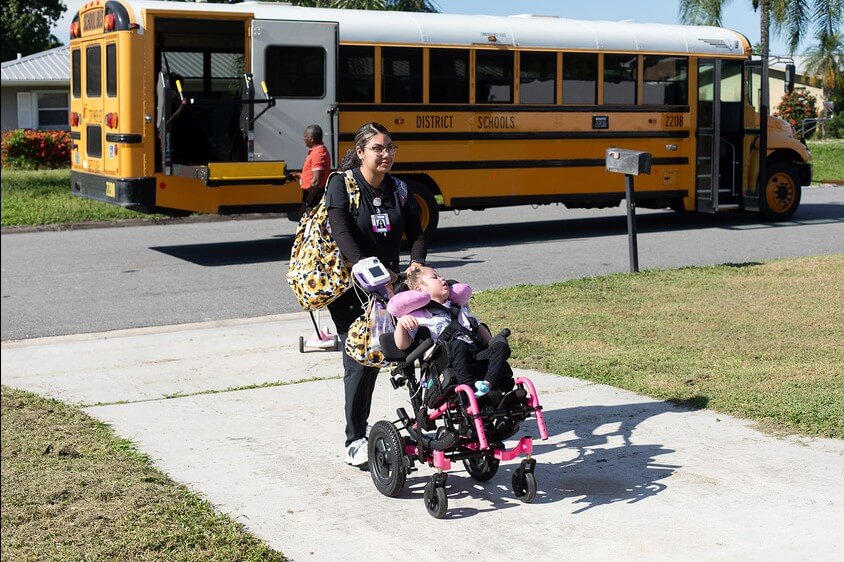Administrators are expected to know and implement a thousand logistics related to running a school district — the first of which being the securement of highly qualified staff to serve students. After all, serving children is a school district’s most fundamental objective.
But what happens when good administrators make strong efforts to secure great people and positions remain vacant? In particular, within special education, what happens when administrators are left asking, “Where is the SLP?”
School district administrators may confront the beginning of the school year with SLP vacancies for a number of reasons, including:
- Shortage of qualified personnel
- Difficult geographic area for which to lure candidates
- Unsuccessful recruitment efforts
- Short-term or temporary vacancies due to illnesses, personal leaves, or mid-year retirements
What happens when there is no SLP in place? First and foremost, we are abandoning the already established needs of children. SLP staffing is about supporting families within our communities and serving children of all abilities. In addition to this clear consequence to children, any interruption of IEP services also constitutes a risk of violating special education compliance regulations.
Of course, staffing isn’t about checking a compliance box, but an interruption in speech service can result in costly consequences for districts. We’ll outline six common compliance mistakes that districts face, the financial consequences of failing to meet regulations, as well as a framework for addressing this compliance risk before it becomes a problem.
The View From Above
School administrators and SLPs can both agree that no one wants to experience an interruption in service. Not only is it detrimental to students and their families, but it can also have severe financial implications for districts. Therefore, as much as possible, IEPs should be executed as written.
However, with high demands and tight program budgets, school district administrators are often forced to balance risky decisions (e.g., extending recruitment or hoping for someone’s quick recovery) with the risk of forgoing service continuity.
Sometimes, as with the diagnosis of a serious illness, an interruption in service simply can’t be anticipated. However, for other kinds of short-term leaves, preventing such an interruption is possible by securing private help for vacant positions or planning for family leaves in advance. In these cases, and considering the potential fiscal repercussions involved — any preventative expense incurred to avoid an interruption in service will save a school district far more in the future.
When to Worry
If a suspension in service is limited to one or two days, school district programs are not at risk of being found “out of compliance.” However, with a service interruption of as little as two weeks, parents are within their legal rights to request an IEP review to discuss how service and compensatory services will be addressed for their child.
Unfortunately, most school districts do not have a substitute pool of speech pathologists to draw from in the case of temporary vacancies (as general and special education teachers often do). Nevertheless, a shortage of substitutes or other recruitment challenges does not exempt school districts from providing service or adhering to school calendar timelines.
Additionally, while these compliance issues primarily denote a consecutive absence, any pattern of intermittent but consistent vacancies could also be deemed an interruption in service. Such a pattern could result in the same students missing multiple scheduled speech therapy sessions over months, and parents could contend that their child had been denied mandated service, thereby putting the district out of compliance.
Administrators have options, the most straightforward of which include short- and long-term agreements with private resources. While these partnerships require a larger investment, they greatly outweigh the far-reaching and expensive ramifications that stem from delayed or interrupted service. Most importantly, by taking proactive measures to avoid these vacancies, districts can ensure their students have the social and academic resources they need to be successful.
How You Compare and How to Improve
In a seminar for school administrators, Dawn White (ESC20) outlined school districts’ most common mistakes in not appropriately implementing a student’s IEP. Of the eight reviewed, five are related to technical portions of the IEP, and only three are related to service.
Technical mistakes related to implementing an IEP:
- Modifications
- Schedule of service
- Behavior intervention plans
- Content mastery
- Instructional settings
Service mistakes related to implementing an IEP:
- Related services
- Speech therapy services
- ESY services
For this reason, school administrators are advised to scrutinize their arrangements for speech-language services. In many cases, students receive these services in both early intervention and within the K-12 school settings — making any delay or interruption present an even greater risk.
Consequences of Interrupting SLP Service
Lawyer Peter W. D. Wright, who specializes in special education law and advocacy, summarizes the legal compensation expectations of missed service on an IEP:
“If the school agrees that the service has not been delivered, then the only question is how to make up for the lost service effectively.”
In other words — why the service may have been interrupted is irrelevant.
Wright asserts that if any interruption in service occurs, scheduled therapy sessions must still be individually accounted for. If one hour is missed, one hour needs to be provided.
This means that upon any disruption in speech therapy services, there is legal precedent for parents to request any of the following six compensatory remedies at the expense of the district:
1. Doubling weekly service
“Sally” is scheduled for speech therapy twice a week in her elementary school, but the SLP is not hired until a month into the school year. By virtue of the legalities outlined by Wright, Sally and the entire caseload of students are now “owed” additional speech sessions. As a compensatory measure, Sally’s parents request that her scheduled therapy sessions be doubled to four per week until the “debt” is repaid.
Trying to “double up” on weekly service for an entire caseload of students would be logistically impossible for any SLP, requiring additional hours (and subsequent expense) or the need to bring in short-term private help — which is not only expensive but hard to secure.
2. Service during vacation periods
“Douglas” is scheduled for speech therapy once a week. The SLP retires at the end of January, and a substitute SLP begins in mid-March — resulting in a six-week interruption in speech service. Douglas is now owed six weeks of sessions, and his parents request service to continue past the last day of school into summer vacation.
If the district is able to retain its employees over the summer (in accordance with union agreements, etc.), the cost may be higher. If such continuity is not possible, the district will be obligated to seek out a short-term SLP contract, which comes with significant cost implications and caseload concerns.
3. Reimbursement for outside private services
“Madi” has an IEP that mandates she receive social skills instruction once a week. Due to a delay in services at the beginning of the school year, Madi does not begin the social skills group until November.
Because Madi’s parents do not want services extended into vacation periods and the SLP cannot offer an additional social skills group during the school week, they seek out outside private services — and request that the district compensate them for this expense.
4. “Banking” of lost services to use later
“Kaylee’s” IEP stipulates that she receives articulation and language skill therapy each week. However, her SLP gives notice a month into the school year and leaves on October 15th. A replacement SLP is secured, but it cannot begin until January (after Kaylee’s scheduled re-evaluation).
Following 2.5 months without service, Kaylee’s parents request that the district commit to ongoing additional service time regardless of the outcome of her upcoming re-evaluation. Adherence to this request could open Pandora’s Box of future issues about continuing to work with someone who potentially no longer qualifies for service.
5. Extending services after the maximum age of eligibility
“Zach” is a 21-year-old student in a transition program preparing him for community work and group home living. His IEP outlines 60 minutes a month of speech and language service to support his efforts with this transition. Due to an illness, the SLP serving this group was on medical leave from December until April.
Zach’s parents requested that he continue to receive services in speech and language following his “aging-out” of the public school special education program. The cost of this request requires a redistribution of resources by the district, and the SLP will likely struggle to serve this student without the support of the transition services he was receiving.
6. Requests for awarded financial damages (in addition to service)
Historically, compensatory services have addressed making up the time for any interruption in services. However, legal sources report that some have started to seek financial damages in addition to this compensatory service (Mr. Wright notes, “the law is just developing in this area”).
The request for damages may be a reflection of missed learning opportunities due to the absence of speech and language services. Families may also be seeking financial damages as a means to inform administrations that interruptions in speech and language service will not be tolerated.
Avoid Interrupting Speech Services
Considering the potential costs of noncompliance, forward-thinking administrators must always weigh the cost of an immediate investment against long-term potential expense. When filling a vacancy, short-sighted financial thinking leads to traditional recruiting efforts as a means of keeping expenses down. This approach:
- Fails to mitigate against the risk of additional costs in the case that a candidate cannot be secured
- Lays the groundwork for potential internal employee discontent and conflict as workloads are shifted/increased to address short-term and/or long-term vacancies
- Strengthens the threat of increased financial costs when the gamble of recruiting fails
Solutions for Mitigating Compliance Risk
For more than 10 years, we’ve been helping school districts across the country address compliance concerns and avoid costly errors. One approach that we have seen strong results with (and that many administrators are not yet aware of) involves sourcing private help outside of the district as a flexible solution for SLP staffing challenges — whether needed all year or for just a month or two.
But there are many concerns to consider associated with navigating the complex landscape of private providers, namely:
- When utilizing private agencies, it is difficult to guarantee that you will receive highly-qualified specialists and that students will receive the singular attention they deserve.
- Some staffing companies claim to have personnel available to assist throughout the year. However, it is not uncommon for them to make this claim, secure a district’s interest and commitment, and then rapidly search for a potential recruit to fill the position.
- Many agencies do not permit administrators to interview potential candidates before their placement — meaning that districts are “stuck” with their assigned SLP and often do not even have the opportunity to meet him/her until the first day of school.
- Should the school district want to hire the candidate following the placement, a significant buy-out fee is usually required.
Below, I’ve outlined a 6-step framework for ensuring that school district administrators select the right SLP partner to meet their unique staffing needs with the most program (and financial) flexibility possible.
- Seek to work with companies that share your values of putting students first. These are the companies that value and nurture experienced and highly qualified staff ready to address your challenges.
- Work with a company that offers short-term help. Securing short-term help (whether for two weeks or two quarters) is the #1 way to eliminate the risk of families demanding compensatory service.
- Ensure your private specialist plans to be on-site in your building periodically during the month. In a school setting, specialists must develop relationships within a building to understand a child’s classroom, curriculum, and instructional demands. This is effectively done when the SLP is in the building intermittently.
- Work with a company with a strong internal network of support for specialists. Ask direct questions: if the specialist needs additional support or alternative materials, who do they turn to? A good company will provide more than an annual review to staff.
- Identify a company that can move swiftly to implement change in your setting. If a specialist is not the right fit for your program, you want to work with a company that immediately offers alternative solutions.
- Ask how a company puts kids first. The investment being made in quality service is not just about ensuring compliance. The right partner will explain how it’s about kids and give you examples of business practices they’ve implemented — not in their own financial interests, but for the benefit of students.
The financial cost of securing short-term help or a year-long specialist is a significant consideration for administrators, especially with tight budgets. However, this expense is minimal in comparison to the immediate and long-term risks of not complying with necessary services for students.
However, the true cost comes at the expense of students within special education, who have invested every part of themselves to be successful in the general education curriculum. Speech and language services, as outlined on an IEP, are designed to give these dedicated students a more level playing field and the opportunity for success. Any interruption in service sends a message to students that direct service is a “lowest cost possible” consideration only. Not only does such thinking warrant the penalties of non-compliance, but it demonstrates that students are not a program’s first priority.
School district administrators generally agree there is a point in which you must consider outside private assistance, and this paper serves as a framework for navigating that consideration.
Taking a proactive approach to these needs is the foundation for a successful district experience — or, more importantly, a successful student experience.





